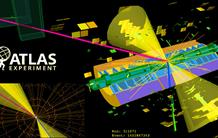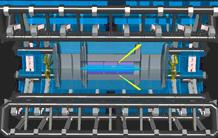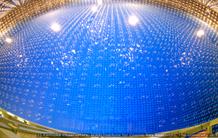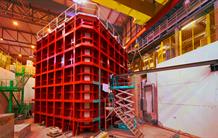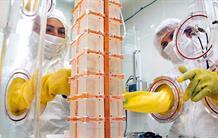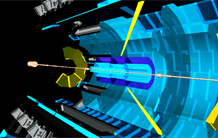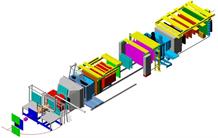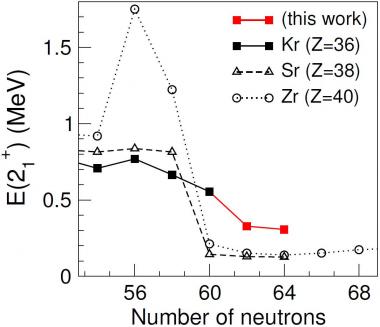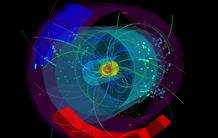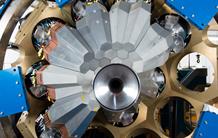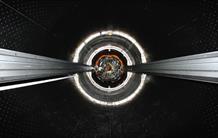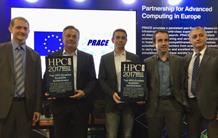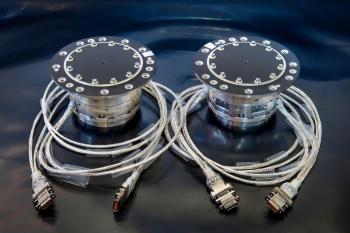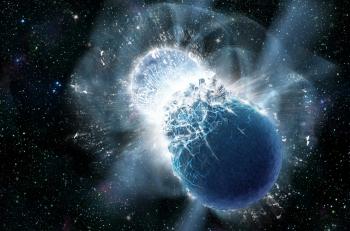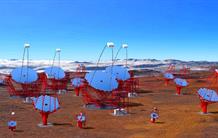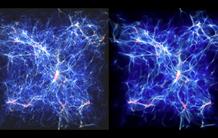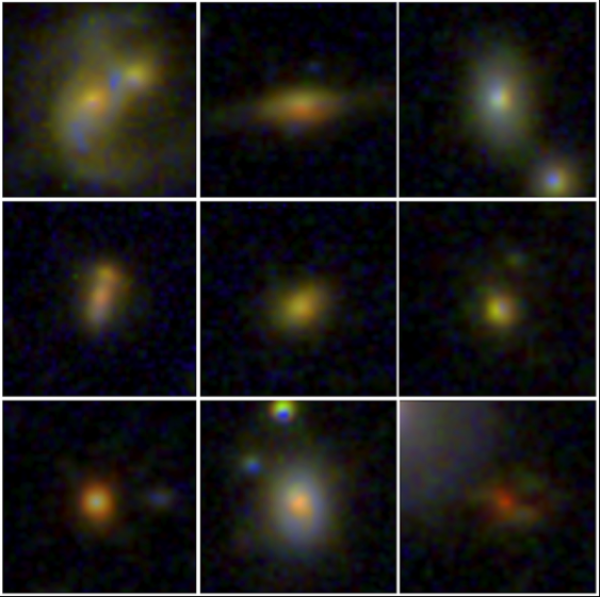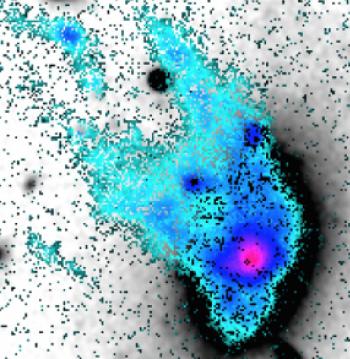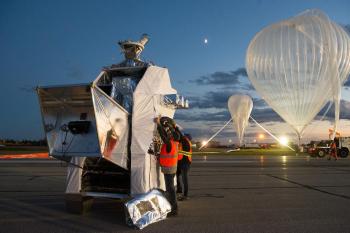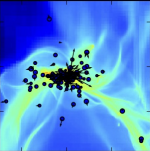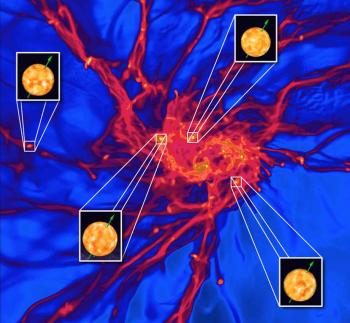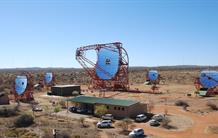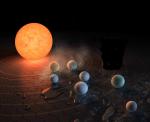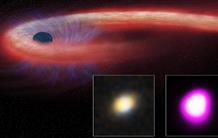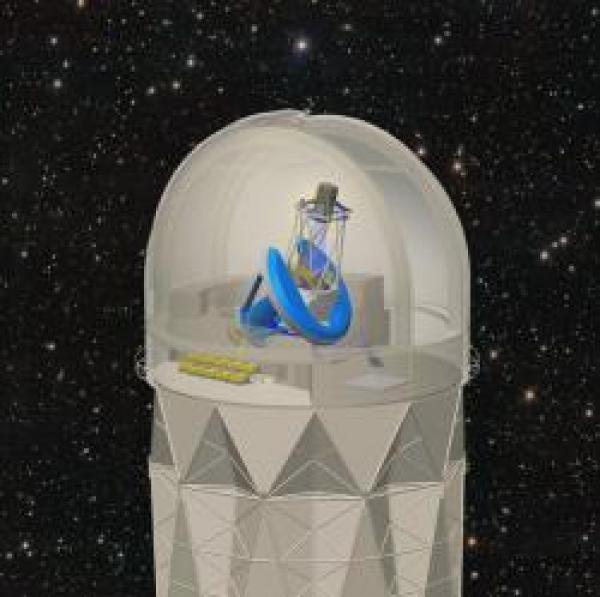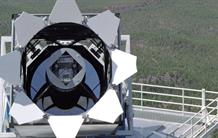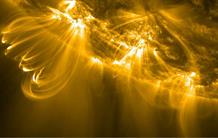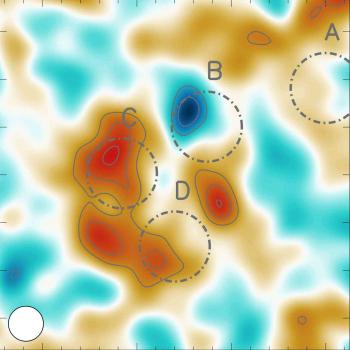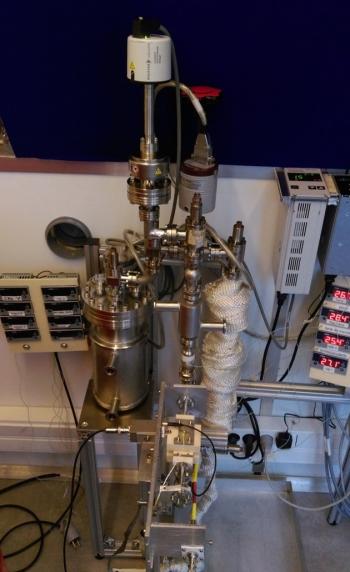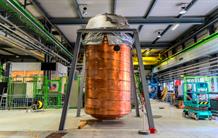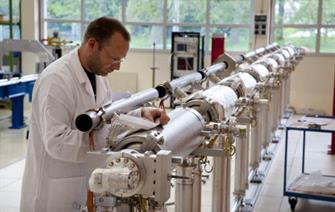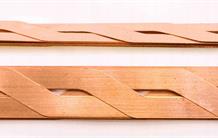For more than 10 years now, Irfu physicists and engineers have been developing in Saclay the necessary equipment for the GBAR experiment, designed to test the behaviour of antimatter under terrestrial gravity. An important step has just been taken with the installation at the Cern of a new positron source using on an electron linac, and the transport to the Cern of the positron trapping system built at Saclay.
The new source produced its first positrons on November 17, 2017. The installation of the traps is in progress, to be operational when the antiprotons arrive, scheduled for spring 2018.
The LHC's Atlas collaboration at Cern has observed a rare process: the production of Higgs bosons in association with a top quark and top antiquark pair. This work, supervised by an Irfu researcher, opens up perspectives on the study of the Higgs mechanism that gives mass to particles.
Data collected at the LHC (Cern) were processed to provide the most accurate assessment of an asymmetry in top quark and top antiquark production. The result is that the measured value is compatible with the prediction of the standard particle model.
The ATLAS collaboration at CERN's LHC has found the first direct evidence for the rare process of high-energy light-by-light scattering, where two photons interact and change direction. This phenomenon was predicted several decades ago by quantum electrodynamics, i.e. the quantum theory of electromagnetism.
The data collected between 2010 and 2017 by the T2K collaboration (Tokai To Kamiokande) and the reactor neutrino experiments strengthens the trend announced a year ago—neutrinos and antineutrinos have seemingly different behavior.
The new-generation liquid argon detector used in the WA105 experiment at CERN has collected its first signals. This prototype is used in preparation of the Deep Underground Neutrino Experiment (DUNE) for neutrino observations on a mass scale, which is due to start in 2026 in the USA. This research involving IRFU aims, in particular, to shed light on the origin of matter and antimatter.
Physicists from IRFU have announced that no "big brother" of the Higgs boson has been detected at the ATLAS experiment at CERN's LHC. Their results rely on new analyzes with higher sensitivity.
After four years of study, the Luminescent Underground Molybdenum Investigation for Neutrino mass and nature (LUMINEU) collaboration has selected lithium molybdate for the manufacture of scintillating bolometers. These ultrasensitive particle detectors will be used for neutrinoless double-beta-decay searches. Should evidence of the latter be highlighted, neutrinos would merge with their antiparticle and the absolute mass of the neutrino would become accessible.
Light-by-light scattering, predicted in 1936, was observed for the first time by the ATLAS experiment at the LHC, thanks to "ultra-peripheral" collisions of lead ions. It is of particular interest to physicists, as it is the result of interactions between a vacuum and intense electromagnetic fields.
The physicists from the Compass collaboration at Cern, which comprises a team from Irfu, have just published the results of a new measurement of the quark structure of the proton [1]. This uncommon but eagerly awaited measurement tends to confirm one of the basic assumptions of the theory of the strong interaction, the Quantum Chromodynamics (QCD). According to QCD, the complex reaction between two particles in a collision of sufficiently high energy can be separated (factorized) into two contributions: the interaction itself and the quark distribution functions inside the interacting particles. To examine the concept of factorization, the experimenters measured the same quantity called asymmetry, but using two different physical processes: first with a muon beam and then with a pion beam. The result is uncommon because paradoxically, in order to confirm the QCD predictions, the two processes must produce opposite-sign results.
To ascertain the "strangeness" property of the proton, an international collaboration including IRFU has produced, starting from protons, other particles containing a "strange" quark and characterized them. These high-precision measurements carried out at CERN in Geneva will lead to a better understanding of the contribution of strange quarks to the nucleon's spin.
According to the ALICE collaboration at LHC (CERN), certain rare proton collisions have properties that are similar to those of a quark–gluon plasma. In the past, these properties had been observed for collisions of heavy nuclei only. The physicists are now confronted with a new enigma: how can a state of quark–gluon plasma emerge in a system as "small" as that generated by a collision between two protons?
Take a very elongated nucleus of strontium-98, remove two protons... and it becomes a sphere. Although this abrupt shape transition, observed for the first time at GANIL, remains unexplained, a deeper understanding of this phenomenon will allow the physicists to know a little more about the complex organization of nucleons in the nucleus.
A team from IRFU, a member of the ALICE collaboration at CERN, has coordinated the analysis of J/ψ particles produced during lead-lead collisions at the LHC (CERN). Their results provide a solid indication of the existence of a quark–gluon plasma.
An international team led by IRFU and the Japanese research institute RIKEN was able to study the structure of a neutron-rich zirconium nucleus (110Zr)—a first, calling certain models into question. Produced by an accelerator at RIKEN and measured by the MINOS detector, this heavy nucleus proves to be more deformed than expected.
The dynamical view of the internal structure of the nucleon is conveniently described in terms of ‘electromagnetic form factors’, that contain the information on the charge and magnetic currents created by the constituent quarks and gluons. Electron scattering allows to characterize the nuclear matter, which distribution within a radius of 1 fm (10-15 m) is far from being uniform. This matter can be created in electron-positron annihilation or annihilate when matter and antimatter collide in a proton-antiproton collision. The same form factors formally enter in the description of these reactions. They bring the secret of the matter creation from the quantum vacuum. IRFU, following pioneering experiments at Saclay (ALS), participated to several experiments in this topic, in scattering reactions (at Jefferson Lab, USA) and in annihilation reactions (SLAC, USA). A future experiment will measure these form factors in a large kinematical domain: the PANDA experiment at FAIR (Darmstadt,Germany). A realistic computer simulation of the expected precision of this measurement has recently been published in the EPJA and selected to make the cover page of the journal. The expected precision of the reaction: antiproton-proton annihilation into a lepton pair, will allow for the first time the individual determination of the electric and magnetic form factors in the time-like region.
How the constituents of the matter, the quarks and the gluons, do interact?
Electromagnetic form factors offer an essential information on the dynamical properties of this interaction. They acquire, however, a different meaning in the different kinematical regions. In the scattering region (called space-like) they carry the information of the spatial dimension (the electric charge density), whereas in the annihilation region (the time-like region) they carry a time-dependent information, that can be interpreted as the formation time of the quark-antiquark pairs from the quantum vacuum and of their evolution in time towards the formation of a proton-antiproton pair.
The reaction of interest here is the proton-antiproton annihilation into a lepton pair. The experimental challenge consists in detecting an electron-positron pair hidden in a hadronic background that is more important by several orders of magnitude. Indeed, the initial particles being hadrons (i.e., particles driven by the strong interaction) the probability to create hadrons is millions of time higher than leptons (particles driven by the weak and electromagnetic interactions), in particular electrons and muons. The most difficult reaction to be subtracted from the background is definitely the production of two charged pions, as the pions are the lightest hadrons and the momenta of pions and electrons are comparable. The reconstruction of the kinematics allows to reject the reactions with more particles in the final state, the neutral pions that disintegrate into two photons, as well as secondary particles. Most of all, the reconstruction of the energy loss in the electromagnetic calorimeter is discriminative for the identification of electrons with respect to pions.
At the World SuperComputing'17 Congress in Denver (United States), which brings together more than 10,000 HPC experts, CEA researchers, members of an international team, received the "2017 HPCWire Publishers Award" for outstanding results based on high-performance computing that unlock the secrets of star magnetic cycles (HPCWire Editors Choice Awards 2017, Top HPC-enabled Scientific Achievement). HPCWire is the world leader in new sources of information in the field of supercomputing.
The Near IR Spectrometer Photometer (NISP) is an infrared spectro-photometer that will equip the Euclid Space Telescope (launch planned for 2021) to better understand dark matter and dark energy. After three years of R&D leading to a qualification model, and 6 months for the construction and testing of the flight model, the two NISP cryomotors successfully passed all the acceptance tests in November. A team of physicists, engineers and technicians from CEA-Irfu is ready to deliver them to the Euclid/NISP instrumental consortium. These cryomotors are designed to rotate the filter and grey carrier wheels1 that will determine the observation mode of the NISP camera in photometry or spectroscopy. These two modes are essential for measuring the shape and age of galaxies.
1A grism is a prism whose one side is machined to form a diffraction grating to allow only one wavelength to pass through.
A large part of the exoplanets known today are in very close orbit around their star, allowing very intense interactions between the planets and the host star. An international collaboration, led by researchers from Department of Astrophysics-AIM Laboratory at CEA-Irfu, has shown that these planets in close orbits migrate rapidly, due to the combined effect of tidal forces and magnetic forces. This study provides essential elements for understanding the formation and evolution of star-planet systems. These migration effects should soon be observable by missions like PLATO (PLAnetary Transits and Oscillations of Stars) of the European Space Agency (ESA) which will study the habitability zone of the planets. These results are published in the October 2017 issue of Astrophysical Journal Letters.
Using a range of detectors developed with the participation of the CEA, physicists at CEA-Irfu have scrutinized the region from which the gravitational wave was detected on August 17, 2017 by LIGO-VIRGO facilities. Unlike the four previous detections of waves of the same type discovered since 2015, this new vibration of space, called GW170817, is of different origin. It does not result from the fusion of two black holes but of two densest known stars, the neutron stars.
Thanks to the INTEGRAL satellite in orbit, the astrophysicists of the Department of Astrophysics-AIM Laboratory (CEA, CNRS, Univ Paris Diderot) were able to show that the wave GW170817 was accompanied by a gamma burst, a brief emission of gamma rays emitted just 2 seconds after the fusion of the two stars. By pointing in record time one of the giant telescopes of the VLT (Chile), they also participated in the study of the visible light emission that followed the fusion, showing in particular that this light was not polarized.
Physicists from the Department of Particle Physics of CEA-Irfu also analyzed the data obtained by the ANTARES experiments for neutrino and H.E.S.S. for the search for very high energy gamma rays, showing that the GW170817 wave did not provide detectable emission.
The study of this new phenomenon, never observed directly so far, offers many exciting perspectives for astrophysics as the possibility of better understanding the origin of the heavy elements of the Universe and even the ability to measure in a complete independent way the rate of expansion of the Universe.
All of these outstanding results are published in a series of articles presented in the journals Nature, Astrophysical Journal and Physical Review Letters on October 16, 2017.
For more information : see the French version
The Cherenkov Telescope Array (CTA) consortium brings together 1300 scientists from 32 countries. They have published their scientific aims in a document over 200 pages long. This is the result of several years of work, and includes contributions from approximately fifteen Irfu researchers involved in X-ray and gamma-ray observatories (Fermi, Integral, XMM-Newton, H.E.S.S., etc.).
Several decades after its discovery, dark matter remains enigmatic. Researchers from IRFU have tested three models of dark matter in which the formation of large structures was modeled using supercomputing. The reconstruction of large structures from observations of quasar spectra favors the hypothesis of a standard "cold" dark matter and sets some of the strongest constraints on these invisible masses.
An international team from the Sloan Digital Sky Survey (SDSS) has carried out the first large-scale spectroscopic analysis of quasars, and was able to create a full 3D map of the universe and its large structures as it was 6 billion years ago. For now, the standard model of Cosmology, based upon Einstein's general theory of relativity, is confirmed.
Using images obtained with the Hubble Space Telescope, an international team of researchers led by Yu-Yen Chang from the Service d’Astrophysique-Laboratoire AIM at CEA–IRFU showed that some galaxies hosting an active nucleus are much more compact than those without nuclear activity. This discovery sheds new light on the physical processes driving the evolution of super-massive black holes at the center of distant galaxies. It suggests that the huge amount of gas needed for their growth could be funneled to the central region following the violent gravitational instabilities that occur within the galaxy gaseous disk. These instabilities may trigger a phase a dynamical contraction, hence explaining the ultra-compact morphology of the galaxies studied here. These results are published in the Monthly Notices of the Royal Astronomical Society.
An international team including a researcher from the AIM Laboratory-Astrophysics Department of CEA-Irfu has just discovered an elliptical galaxy of completely unexpected shape within the galaxy cluster Abell 2670. Deep observations made by the new MUSE multi-spectrograph recently put into operation at the European Observatory VLT in Chile revealed a highly deformed elliptical galaxy, showing in particular long gas tails and star formation regions normally absent in this type of galaxy. Astronomers now assume that this galaxy has undergone a recent fusion with another gas-rich galaxy. Much of this gas was then driven to the center of the elliptical galaxy during the collision. These results are published in the Astrophysical Journal Letters of May 2017
The PILOT astrophysics experiment has been launched the 17th April under a stratospheric balloon from Alice Springs in central Australia. The aim is to observe the polarization of the emission of dust particles present in the interstellar medium of our Galaxy and the nearby galaxies. With a mass of nearly one ton, PILOT [1] uses the biggest balloons launched by the National Center for Space Studies (CNES). It was developed by the Institute for Research in Astrophysics and Planetology (CNRS / CNES / Paul Sabatier University) and the Institute of Space Astrophysics (CNRS / Université Paris-Sud) and the Institute of Research into the Fundamental Laws of the Universe (CEA-Irfu). Detectors capable of detecting infrared radiation from dust have been developed at the CEA and are the result of research done to realize the PACS camera that equiped the Herschel space observatory.
The proto-clusters, which are the birth sites of stars, are formed non-uniformly inside molecular clouds of the interstellar medium. Studying the steps leading to the collapse of pre-stellar dense cores is essential to understanding the star formation. Using both numerical simulations carried out on massively parallel computers and an analytical approach, two researchers from the Astrophysics Department / AIM Laboratory of CEA-Irfu, Y.-N. Lee and P. Hennebelle, have shown that certain properties of a stellar cluster are determined before the star formation starts, especially in the gaseous phase and that the gravity and turbulence play a major role. This work, published in two articles in the journal Astronomy & Astrophysics, provides a better understanding of parameters related to star formation such as the initial mass function and their efficiency and rate.
The stars do not play dice! It is the extraordinary discovery that the researchers of the Department of Astrophysics-Laboratoire AIM of the CEA-Irfu made by succeeding in determining the orientation in the space of the axis of rotation of stars belonging to two clusters of stars, thanks to asteroseismology. About 70% of the observed stars have perfectly aligned axes of rotation, in formal contradiction with the star formation models which predict that these axes of rotation should be randomly distributed. Numerical simulations showed that, most likely, these stars had managed to retain the initial rotational motion of a cloud that gave rise to the cluster. This discovery, if confirmed in other clusters, could lead to reconsideration of the fundamental processes of star formation. These works make headlines in the journal Nature Astronomy of March 13, 2017
Watch the author's interview : The mysterious alignment of the rotation axis of stars
The mysterious alignment of the rotation axis of stars 
The electronics developed by IRFU now equips the four oldest gamma-ray telescopes of H.E.S.S. (High Energy Stereoscopic System) in Namibia. Making it possible to optimize the simultaneous operation of all five H.E.S.S. telescopes, and confirming the technical choices for its successor CTA (Cherenkov Telescope Array).
Seven planets of terrestrial size and moderate temperature gravitate around the star Trappist-1, a small cool red star located at 40 light years from Earth. Better: at least three of them are in conditions compatible with the presence of liquid water on their surface. This was discovered by an international team involving CNRS, CEA and UPMC researchers at the Astrophysical Laboratory of Bordeaux (CNRS / University of Bordeaux), the Laboratoire de Météorologie Dynamique (CNRS / UPMC / École Polytechnique / ENS) and the Astrophysics Department - AIM Laboratory (CEA / CNRS/ Paris Diderot University). The planetary system orbiting the star Trappist-1 is one of the most astonishing and richest, especially in terms of scientific prospects: beyond the determination of the orbit and the mass of these planets, it will be possible, in the near future, to highlight the possible presence of atmospheres. This study is published in Nature, 23 February 2017.
At the center of a small galaxy located about 1.8 billion light-years from Earth, a giant black hole swallowed a star for about a decade, which is exceptionally longer than any observed episode of this kind. This discovery was made by an international collaboration involving an astrophysicist from IRFU, thanks to a trio of orbiting X-ray telescopes.
The Dark Energy Spectroscopic Instrument (Desi) will analyze the light emitted by 35 million galaxies and quasars at various times in the past of the Universe and up to 11 billion years to better understand dark energy. Its move into the construction phase in 2016 crowns several years of research and development that have resulted in a solid design and a credible observation strategy. Irfu, a partner in the project from the outset, has played a key role. A look back at a year that saw the project become a reality.
A new phase begins for DESI
The homogeneity of our universe is among the founding principles of cosmology—yet are we really sure that it is so? Until now, the main argument supporting the idea that it is homogeneous was based on a coherence test that implicitly used the homogeneity of the universe for its demonstration.
Astrophysicists from IRFU have studied the evolution over time of the "wind" in stars similar to the Sun. They were able to perform 3D computer simulations of these stellar winds based, in particular, on spectropolarimetric measurements of the surface magnetic field of the stars.
A team of researchers led by Rémi Adam (Laboratoire Lagrange - OCA, UCA, LPSC Grenoble, CNES), Iacopo Bartalucci and Gabriel Pratt (Astrophysics Department- AIM Laboratory at CEA-Irfu) obtained for the first time an image of the gas velocity in colliding clusters of galaxies with NIKA [1], a new generation millimeter camera, at the focus of the 30 m diameter IRAM telescope of Pico Veleta (Spain). NIKA observations, which give accurate mapping of hot gas velocity in clusters, provide a new way to study the collision of clusters of galaxies, responsible for the most energetic events in the Universe after the Big Bang. This work is being published in the journal Astronomy & Astrophysics..
In the field of medical imaging, a IRFU team has launched a challenge: their goal is to image the brain activity with a precision of 1 mm3. Its name: CaLIPSO. The idea consists in an innovative detector technology: both light and ionisation signals produced by particle interactions are detected. For this, a series of technological obstacles must be overcome. One of these crucial steps has just succeeded. It consists in implementing the entire chain of ultra-purification of the detection liquid.
For the first time, an international collaboration involving IRFU has mapped out the largest structures of the universe in 3D, from the movements of thousands of galaxies. This reconstruction includes areas which, until now, were unobservable.
Designed to equip the FRESCA2 testing station at CERN (Facility for the Reception of Superconducting Cables), the niobium-tin dipole magnet of the same name has reached a record 13.3 T magnetic field for a 100 mm aperture. It was designed and developed as part of a collaboration between IRFU and CERN. The objective is a magnetic-field homogeneity 1% over a length of 540 mm.
The faster, more powerful European XFEL free-electron laser[1] was inaugurated on September 1, 2017, near Hamburg, Germany. By producing ultra-bright, trillion-photon X-ray flashes at a frequency two hundred times greater than the best preexisting free-electron lasers (FELs), this next-generation European instrument will allow scientists to map the atomic relief of viruses, decipher the molecular composition of cells, create 3-D images of the nanoworld, and even film chemical reactions. Eleven countries helped build the XFEL, at a cost of €1.2 billion. The French National Center for Scientific Research (CNRS) and Alternative Energies and Atomic Energy Commission (CEA) both played a leading role in the design and construction of the superconducting electron accelerator at the heart of this new international research facility.
[1]. A free-electron laser (FEL) generates photons using electrons that are not bound to atoms. It emits intense, coherent light across a wide range of wavelengths, including microwaves, X-rays, UV, visible light, and infrared. The new European laser specifically produces X-rays.
A dipole magnet, built by a European collaboration involving IRFU from high-temperature superconductors, has produced a 4.5 tesla magnetic field, which is one tesla higher than previous prototypes. Once inserted in a Niobium-Tin dipole magnet, the whole system will produce an 18 T field.



